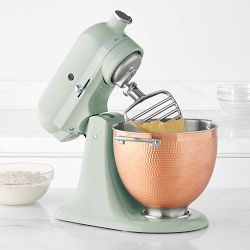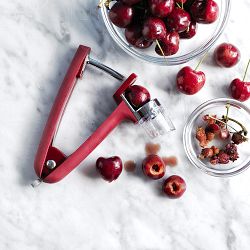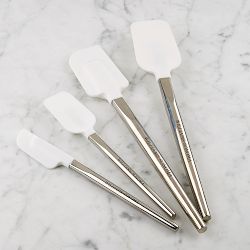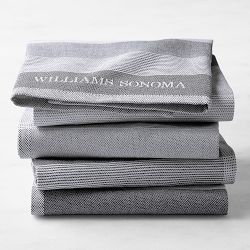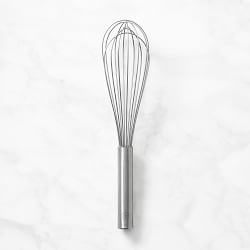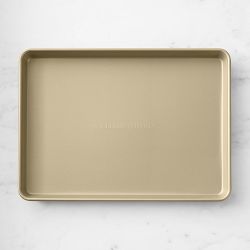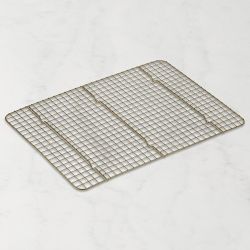Olive Focaccia

A type of Italian flatbread, focaccia can be topped with an endless array of ingredients. Here we keep it simple and call for Castelvetrano olives, a mild-tasting green variety with a buttery, meaty texture. Cut the savory bread into slices and serve with your best extra-virgin olive oil for dipping. This makes a great appetizer for summer gatherings or anytime of year. Enjoy the focaccia warm from the oven or at room temperature—it’s delicious either way.
Ingredients
- 6 1/4 cups (1 lb. 11 oz./765 g) bread flour, plus more as needed
- 2 1/2 cups (20 fl. oz./625 ml) room-temperature water (70° to 74°F/21° to 23°C)
- 3 tsp. sugar
- 1/2 cup (4 fl. oz./125 ml) warm water (105°F/40°C)
- 1 package (2 1/4 tsp.) active dry yeast
- 1 1/2 Tbs. kosher salt
- 7 Tbs. (3 1/2 fl. oz./105 ml) extra-virgin olive oil, plus more as needed
- 3/4 cup (3 3/4 oz./115 g) pitted Castelvetrano olives
- Freshly ground pepper
Directions
In the bowl of an electric mixer fitted with the dough hook, combine the flour, room-temperature water and 1 1/2 tsp. of the sugar and beat on low speed until a shaggy dough forms, about 3 minutes, stopping the mixer to scrape down the dough hook and sides of the bowl as needed to incorporate all of the flour. Cover the bowl with a towel and let stand while preparing the yeast mixture.
In a small bowl, whisk together the warm water, yeast and the remaining 1 1/2 tsp. sugar until combined. Let stand until foamy, 5 to 10 minutes.
Remove the towel from the mixer bowl. With the mixer on low speed, carefully add the yeast mixture and beat until the liquid is absorbed, about 2 minutes. You may need to stop the mixer and pinch in the water with your hands to help it absorb. Add the salt, increase the speed to medium and beat until the dough is elastic and sticky, 5 to 8 minutes. It will pull away from the sides of the bowl but will remain attached to the dough hook and the bottom of the bowl. If the dough is still too wet and doesn’t become elastic, add up to 8 Tbs. more flour, 1 Tbs. at a time, until the dough has reached the proper consistency.
Coat the inside of a large bowl with 3 Tbs. of the olive oil. Scrape the dough into the prepared bowl and turn to coat with the oil. Cover loosely with plastic wrap and let stand in a warm spot until doubled in size, about 2 1/2 hours.
Coat a 13-by-18-inch (33-by-45-cm) rimmed baking sheet with 2 Tbs. of the olive oil.
Fold the dough over itself in the bowl to deflate slightly. Transfer the dough to the prepared baking sheet. Using oiled hands, gently stretch the dough out to the edges and corners of the pan. If the dough springs back toward the center, cover with plastic wrap and let stand for 10 minutes, then repeat to stretch the dough. Oil one side of a piece of plastic wrap and cover the pan, oiled side down. Refrigerate for at least 2 hours or up to overnight.
One hour before baking the focaccia, remove from the refrigerator and let it stand in a warm spot.
Preheat an oven to 450°F (230°C).
Using the flat side of a knife, smash one-third of the olives. Cut another one-third of the olives in half. Keep the remaining olives whole. Remove the plastic wrap from the pan. Using oiled fingers, press your fingertips firmly into the dough to make deep dimples over the entire surface. Sprinkle with pepper and distribute the olives evenly over the dough.
Bake until the focaccia is deep golden brown all over, 20 to 25 minutes; halfway through baking, drizzle the dough with the remaining 2 Tbs. olive oil.
Transfer the baking sheet to a wire rack and let the focaccia cool for 10 minutes, then drizzle with olive oil. Cut into slices and serve warm or at room temperature. Serves 8 to 10.
Williams Sonoma Test Kitchen

